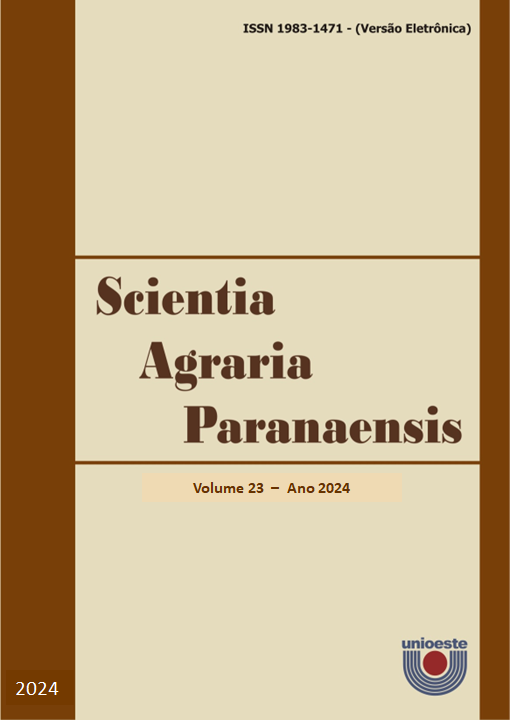Management of leaf spots in soybean cultivation with fungicides at zero application
DOI:
https://doi.org/10.18188/sap.v23.34133Resumo
Soybean (Glycine max) is one of the most important commodities in Brazil. The main factors limiting its production are diseases, with approximately 40 diseases identified in the country, caused by fungi, bacteria, nematodes, and viruses. Foliar spots are common at the beginning of soybean development, and since pathogens can be present from the beginning of cultivation, preventive management is employed with application in the vegetative phase, 30 days after sowing (zero application). This study aims to evaluate the effectiveness of different fungicides from the chemical groups triazoles, strobilurins, multisites, and biological control in controlling foliar spots through zero application. The methodology followed the recommendations of the Ministério da Agricultura, Pecuária e Abastecimento (MAPA-Brazil) according to Normative Instruction No. 13 of 2011, with a randomized block design, 7 treatments, and 5 replications, totaling 35 plots. The treatments, applied 30 days after sowing at the V3 phenological stage, included a control with no application, Bacillus amyloliquefaciens, Picoxystrobin + Ciproconazole, Chlorothalonil, Saccharomyces cerevisiae, Picoxystrobin + benzovindiflupyr, and Tebuconazole + Trifloxystrobin. Disease incidence and severity, live canopy coverage index, and productivity variables were evaluated. The results demonstrate that Picoxystrobin + Ciproconazole and S. cerevisiae were the most effective treatments in reducing foliar disease incidence and severity while enhancing canopy retention and yield. These findings reinforce the importance of integrating chemical and biological control strategies in early disease management, particularly through zero application, to optimize soybean health and productivity.
Downloads
Publicado
Como Citar
Edição
Seção
Licença
Aviso de Direito Autoral Creative Commons
Política para Periódicos de Acesso Livre
Autores que publicam nesta revista concordam com os seguintes termos:
1. Autores mantém os direitos autorais e concedem à revista o direito de primeira publicação, com o trabalho simultaneamente licenciado sob a Licença Creative Commons Attribution que permite o compartilhamento do trabalho com reconhecimento da autoria e publicação inicial nesta revista.2. Autores têm autorização para assumir contratos adicionais separadamente, para distribuição não-exclusiva da versão do trabalho publicada nesta revista (ex.: publicar em repositório institucional ou como capítulo de livro), com reconhecimento de autoria e publicação inicial nesta revista.
3. Autores têm permissão e são estimulados a publicar e distribuir seu trabalho online (ex.: em repositórios institucionais ou na sua página pessoal) a qualquer ponto antes ou durante o processo editorial, já que isso pode gerar alterações produtivas, bem como aumentar o impacto e a citação do trabalho publicado (Veja O Efeito do Acesso Livre).
Licença Creative Commons
Esta obra está licenciada com uma Licença Creative Commons Atribuição-NãoComercial-CompartilhaIgual 4.0 Internacional, o que permite compartilhar, copiar, distribuir, exibir, reproduzir, a totalidade ou partes desde que não tenha objetivo comercial e sejam citados os autores e a fonte.


